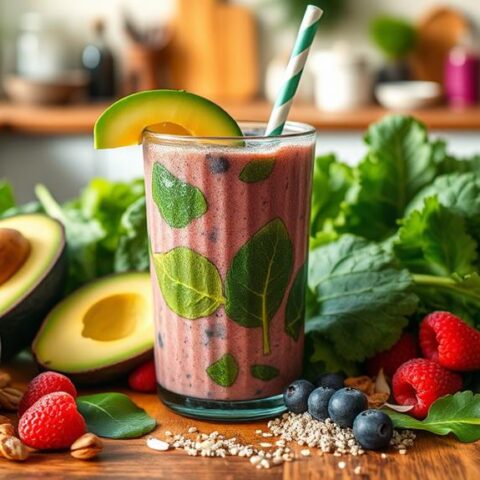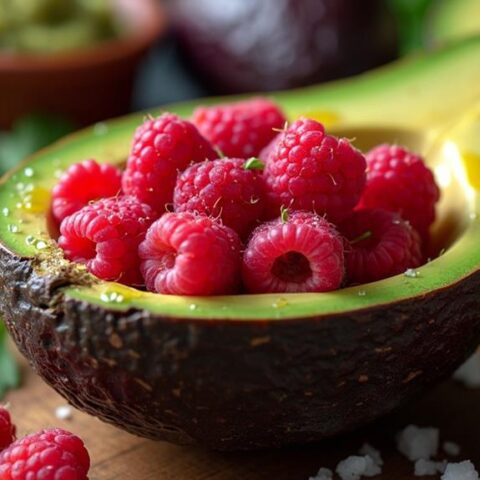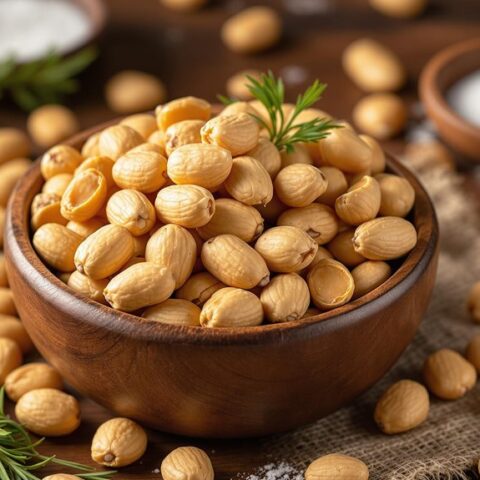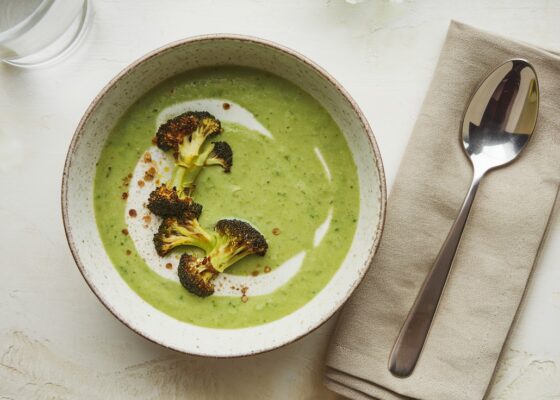
Gluten-free buns are not automatically low in carbohydrates, as they often contain alternative flours and starches that can match or exceed the carb content of traditional wheat buns. Standard gluten-free buns typically contain 14-26 grams of carbohydrates per serving, while some commercial varieties use rice flour, resulting in 20-24 grams per bun. However, specific low-carb options made with almond or coconut flour can provide considerably fewer carbs, ranging from 2-5 grams per serving. Understanding the ingredients and calculating net carbs reveals the true carbohydrate impact.
Key Takeaways
- Gluten-free doesn't mean low-carb, as standard gluten-free buns contain 14-26 grams of carbohydrates per serving.
- Store-bought gluten-free buns often use high-carb ingredients like rice flour, tapioca starch, and potato starch.
- Homemade gluten-free buns using almond or coconut flour can achieve much lower carb counts of 2-4 grams per serving.
- Net carbs in gluten-free buns vary significantly, with fiber content determining the final impact on blood sugar.
- Commercial gluten-free buns typically have higher carb content than homemade versions due to added sugars and refined flours.
Understanding Gluten Free Buns
While gluten-free buns have become increasingly popular among health-conscious consumers, their carbohydrate content often surprises those seeking healthier alternatives to traditional bread.
Made from alternative flours such as almond flour, coconut flour, or chickpea flour, these buns can vary greatly in their nutritional composition. Despite being gluten-free, many commercial options contain approximately 14 grams of carbohydrates per slice, making them unsuitable for those following a low carb diet.
Gluten-free buns made with alternative flours may still pack significant carbs, with commercial options averaging 14 grams per slice.
The presence of processed ingredients, hidden sugars, and various starches in store-bought varieties can further increase their carbohydrate content. It's important to note that refined carbohydrates can quickly convert to glucose, disrupting ketosis for those on a keto diet.
However, home bakers can create lower-carb versions by carefully selecting ingredients like psyllium husk and nut flours, which help achieve desired texture while maintaining reduced carbohydrate levels.
The Basic Carbohydrate Content
The carbohydrate content of gluten-free buns presents a considerable consideration for health-conscious consumers tracking their daily macronutrients. Standard gluten-free buns typically contain comparable carbohydrate levels to their wheat-based counterparts, averaging 14 grams per serving. However, options made with almond or coconut flour provide considerably lower carb alternatives for those following a low-carb diet.
| Bun Type | Carb Content (g) | Fiber (g) |
|---|---|---|
| Standard Gluten-Free | 14-26 | 1-2 |
| Rice Flour Based | 20-24 | 1-2 |
| Almond/Coconut Flour | 2-5 | 2-3 |
| Traditional Wheat | 14-20 | 2-3 |
The carbohydrate content varies considerably based on ingredients used, with rice flour and potato starch-based options generally containing higher levels of carbohydrates compared to alternative flour varieties.
Common Ingredients in Gluten Free Buns
Manufacturers of gluten-free buns rely on a diverse mix of alternative flours and binding agents to recreate the texture and structure traditionally provided by wheat gluten. Common ingredients include almond flour, coconut flour, and tapioca starch, each contributing unique properties to the final product. While these ingredients can help create low carb bread alternatives, many gluten-free buns also contain rice flour and potato starch, which tend to increase total carbohydrates. To enhance texture and reduce net carbs, manufacturers often incorporate psyllium husk, a fiber-rich ingredient that aids in binding and structure. However, added sugars and starches, frequently used to improve taste and texture, can greatly impact the carbohydrate content. Understanding these ingredient combinations is essential for consumers monitoring their carbohydrate intake while maintaining a gluten-free diet. Incorporating sweetener options for keto baking such as erythritol or stevia can help maintain sweetness without adding additional carbs.
Comparing Traditional Vs Gluten Free Buns
Comparing traditional wheat-based buns with their gluten-free counterparts reveals significant differences in both nutritional composition and carbohydrate content. Traditional white buns typically contain higher levels of refined carbohydrates, while gluten-free buns can be formulated with low-carb ingredients to reduce their overall carb content. Keto-friendly sweeteners like stevia and erythritol can be used to add a touch of sweetness to homemade gluten-free buns without adding carbs.
| Type | Carbs per Serving | Common Ingredients |
|---|---|---|
| Traditional | 26g | Wheat flour, yeast, sugar |
| Commercial GF | 14g | Rice flour, starches, sugars |
| Homemade GF | 4-8g | Almond flour, psyllium husk |
While commercial gluten-free buns often contain added starches and sugars, homemade versions can be crafted into keto-friendly options using alternative flours and fiber-rich ingredients. This flexibility in ingredients allows for customization to meet specific dietary needs while maintaining bread-like texture and taste.
Net Carbs Vs Total Carbs in Buns
Understanding net carbs in gluten-free buns requires careful analysis of both fiber content and sugar alcohols, which are subtracted from total carbohydrates to determine the true impact on blood sugar levels.
Calculating net carbs becomes particularly important when evaluating gluten-free buns, as their total carbohydrate content can be misleading without considering the digestible versus non-digestible components.
Some manufacturers incorporate hidden sugars through ingredients like rice syrup or modified starches, making it essential for consumers to examine ingredient lists thoroughly while calculating net carb content.
Calculating Net Carb Content
The distinction between net carbs and total carbs plays an essential role in selecting appropriate gluten-free buns for specific dietary needs.
To calculate net carbs, subtract the fiber content from total carbohydrates, providing a more accurate measure of the bun's impact on blood sugar levels. While many gluten-free buns contain approximately 14 grams of total carbs, low-carb alternatives can offer as few as 2-5 grams of net carbs per serving.
- Calculate net carbs by subtracting fiber from total carbohydrates
- Consider fiber content when evaluating gluten-free bun options
- Watch for added starches and sugars in commercial products
- Look for products that clearly display both total and fiber content
For example, a gluten-free bun with 9.79 grams of total carbs and 7.36 grams of fiber contains only 2.43 grams of net carbs, making it suitable for low-carb diets.
Understanding Hidden Sugars
Many gluten-free buns harbor hidden sugars that can greatly impact their total carbohydrates content, often surprising consumers who assume these products are automatically healthier alternatives. Understanding these hidden sources of carbohydrates is vital for those following a low-carb diet.
| Ingredient Type | Impact on Net Carbs |
|---|---|
| Regular Starches | High Impact |
| Low-carb Flours | Low Impact |
| Added Sweeteners | High Impact |
| Natural Sugars | Moderate Impact |
| Fiber Content | Reduces Net Carbs |
When examining gluten-free buns, it's essential to look beyond the "gluten-free" label and carefully assess the ingredients list. Commercial varieties frequently contain refined starches and sweeteners that contribute to higher total carbohydrates, while homemade versions using low-carb flours can offer better control over hidden sugars and net carbs.
Low Carb Gluten Free Options
While traditional gluten-free buns often contain substantial carbohydrates due to their rice and tapioca flour bases, several innovative low-carb alternatives have emerged to meet the needs of health-conscious consumers.
For those following a keto diet or seeking gluten-free alternatives, nut-based flour options provide excellent solutions with notably lower carbohydrate content. Almond flour has become particularly popular in low-carb bread recipes, typically resulting in buns containing only 2-4 grams of net carbs per serving.
- Homemade psyllium husk and nut flour buns (2-3g net carbs)
- Chia almond bread variations (low-carb profile)
- Protein bread mixes specifically formulated for keto diets
- Custom nut flour blends using almonds and coconut flour
Incorporating a variety of vegetables for nutrients can further enhance the nutritional profile of low-carb gluten-free buns.
Best Flours for Low Carb Buns
When exploring low-carb alternatives for gluten-free buns, understanding the net carb content of different flours becomes essential, with almond flour and coconut flour emerging as leading options at 2 and 6 grams per tablespoon respectively. The combination of these flours with psyllium husk creates an ideal texture while maintaining minimal carb content, making them excellent foundations for gluten-free baking projects. Experimenting with various flour combinations, such as incorporating sunflower seed flour for those with nut allergies or adding flaxseed meal for additional nutritional benefits, can yield successful results while keeping net carbs low. Additionally, using Shirataki Noodles in recipes can offer a low-carb alternative with less than 1g carbs per serving, providing versatility in gluten-free and vegan diets.
Alternative Flours Worth Trying
Savvy bakers seeking gluten-free alternatives can discover a wealth of low-carb flour options for crafting delicious buns. Among the most versatile alternative flours, almond flour leads with just 5 grams of net carbs per quarter cup, while coconut flour provides an impressive 1 gram of net carbs per serving.
When combined with psyllium husk powder for binding, these flours create buns with excellent texture and structural integrity.
- Sunflower seed flour serves as an excellent nut-free alternative to almond flour, containing only 4 grams of net carbs per quarter cup.
- Lupin flour offers superior protein content while keeping net carbs low at 2 grams per serving.
- Coconut flour's high fiber content makes it particularly effective for moisture retention.
- Combining different alternative flours often yields the best texture and flavor results.
Understanding Net Carb Impact
Understanding net carb calculations proves essential for anyone crafting low-carb gluten-free buns, as traditional gluten-free alternatives often pack considerably higher carbohydrate content than their conventional counterparts.
Net carbs per serving can reach up to 14 grams in standard gluten-free buns, while low-carb versions using almond flour typically contain only 2 to 5 grams.
For those following a strict diet and nutrition plan, calculating net carbs involves subtracting fiber content from total carbohydrates.
Ingredients like psyllium husk considerably impact these calculations, contributing beneficial fiber while improving texture.
When selecting flours, almond flour emerges as a superior choice, offering lower net carbs and higher fiber content compared to traditional gluten-free flours like rice or tapioca, which can spike blood sugar levels.
Mixing Flour Combinations Successfully
Successfully crafting low-carb gluten-free buns requires precise combinations of alternative flours, with almond and coconut flours emerging as the leading choices for their superior nutritional profiles and minimal carbohydrate content.
When developing low-carb recipes, incorporating psyllium husk powder alongside these flour combinations proves vital for achieving proper texture and binding properties.
- Almond flour combined with coconut flour creates an ideal balance of protein, healthy fats, and fiber
- Psyllium husk powder acts as an essential binding agent while maintaining low net carb content
- Sunflower seed flour serves as an excellent alternative for those with nut allergies
- Strategic flour combinations help avoid high-carb additives like tapioca starch, keeping recipes truly low-carb
The Role of Fiber in Gluten Free Buns
The nutritional composition of gluten-free buns hinges greatly on their fiber content, which serves multiple essential functions beyond simple structure. When incorporating fiber-rich ingredients like almond flour and psyllium husk, gluten-free buns can effectively lower net carbs while maintaining proper texture and digestibility. The presence of fiber helps regulate blood sugar levels and promotes increased satiety.
| Fiber Benefits | Impact on Gluten-Free Buns |
|---|---|
| Digestive Health | Promotes gut function |
| Blood Sugar | Helps regulate glucose levels |
| Net Carbs | Reduces total carbohydrate count |
| Satiety | Increases feeling of fullness |
| Texture | Improves structural integrity |
These fiber-rich ingredients work together to create a more nutritionally balanced product, offering consumers a healthier alternative while maintaining the satisfying experience of traditional buns.
Store-Bought Vs Homemade Options
When comparing store-bought and homemade gluten-free buns, significant differences emerge in their nutritional profiles and carbohydrate content. Store-bought varieties typically contain higher levels of refined carbohydrates and added sugars, often reaching 26 grams of carbs per bun, while homemade alternatives can be tailored to maintain a low-carb profile of 2-4 grams per serving. Homemade options allow for the use of low-carb flours like almond and coconut. Store-bought versions frequently contain starches and preservatives that increase carb content. Psyllium husk can be incorporated into homemade recipes for improved texture without adding net carbs. Making gluten-free buns at home enables complete control over ingredients and carbohydrate levels. The ability to customize ingredients in homemade gluten-free buns makes them a superior choice for those following a low-carb lifestyle. Additionally, incorporating nutrient-dense protein sources into your homemade recipes can enhance their nutritional value, supporting muscle maintenance and overall health.
Reading Nutrition Labels
Steering through nutrition labels on gluten-free buns requires careful attention to detail and understanding of key components that impact carbohydrate content.
When reading nutrition labels, consumers should first identify the total carbohydrates, which typically average around 14 grams per serving, and factor in dietary fiber to calculate net carbs.
Of particular importance is the serving size, as manufacturers may base their nutritional information on smaller portions than expected.
Additionally, scrutinizing ingredient lists helps identify products made with alternative flours, such as almond or coconut, which generally contain fewer carbs than those using rice or tapioca flour.
Those following a low-carb diet should be particularly vigilant about added sugars and starches, which can greatly increase the total carbohydrate content.
Alternative Bun Substitutes
Beyond traditional gluten-free buns lies a world of creative, carb-conscious alternatives that offer both variety and nutritional benefits.
Discover innovative, health-forward alternatives to standard buns that enhance both your dining experience and nutritional intake.
For those seeking low-carb options, several alternative bun substitutes provide excellent solutions while maintaining flavor and functionality. While classic gluten-free buns contain approximately 14 grams of carbs per slice, natural alternatives appreciably reduce carbohydrate intake without sacrificing the burger experience.
- Portobello mushroom caps serve as hearty replacements with only 3 grams of carbs
- Cauliflower buns provide a bread-like texture while containing just 5.1 grams of carbs
- Crisp lettuce wraps offer the lowest carb option at 2.6 grams per serving
- Grilled eggplant slices present a satisfying alternative that maintains moisture while keeping carbs minimal
Making Smart Bun Choices
When selecting gluten-free buns, consumers should carefully examine nutrition labels to identify hidden carbohydrate sources, particularly in commercial varieties that often contain rice flour and added sugars. Understanding the carbohydrate content differences between various bun types, from store-bought options averaging 14 grams to homemade alternatives with as few as 2 grams per serving, helps make informed choices for specific dietary needs. Those seeking to minimize carb intake can opt for homemade versions using almond flour and psyllium husk, or explore creative alternatives such as lettuce wraps and grilled portobello mushrooms. It's crucial to regularly track carbohydrate intake to ensure compliance with daily carb limits and maintain dietary goals.
Smart Substitution Tips
Making smart choices with gluten-free buns requires careful attention to ingredients and nutritional content, as many commercial options can secretly harbor high carbohydrate levels.
When seeking low-carb alternatives, consider substituting traditional buns with nutritious options that maintain satisfaction while reducing carbohydrate content.
- Choose buns made with low-carb flours like almond or coconut flour, enhanced with psyllium husk for better texture.
- Replace traditional buns with crisp lettuce wraps or grilled portobello mushrooms.
- Look for homemade recipes that allow control over ingredients and carbohydrate content.
- Consider vegetables like sliced eggplant or zucchini rounds as creative alternatives.
These smart substitutions can considerably reduce overall carb intake while still providing an enjoyable eating experience, making them ideal choices for those following low-carb dietary patterns.
Counting Carbs By Type
The complexity of carbohydrate content in gluten-free buns demands careful attention to ingredient types and their relative impact on total carb counts.
When examining different varieties, traditional gluten-free buns made with alternative flours typically contain around 14 grams of carbs per slice, mirroring conventional bread products.
However, low-carb gluten-free options made with almond flour or incorporating psyllium husk as a binding agent can dramatically reduce carbohydrate content to 2-5 grams per serving.
Commercial products require particular scrutiny, as manufacturers often add sugars and starches that increase carb levels.
For ideal carb management, consumers should focus on products specifically labeled as low-carb or consider homemade alternatives using nut-based flours, which provide better control over ingredients and typically offer superior nutritional transparency.
Impact on Blood Sugar Levels
Understanding blood sugar response to gluten-free buns requires careful consideration, as these alternatives often contain higher carbohydrate levels than their traditional counterparts.
The carbohydrate content in these buns can greatly impact blood sugar levels, particularly when made with refined flours and starches. While ingredients like psyllium husk can help moderate the insulin response, many gluten-free options still pose challenges for blood sugar management.
- Gluten-free buns average 14 grams of carbs per slice, higher than regular bread
- Refined flours in these products can cause rapid glucose spikes
- Some varieties have glycemic indices comparable to sugary foods
- Fiber-rich ingredients can help slow carbohydrate absorption
Those monitoring their blood sugar should carefully review ingredients and consider portion sizes when consuming gluten-free buns.
Keto-Friendly Bun Solutions
Those following a ketogenic diet can explore various low-carb alternatives to traditional gluten-free buns, including homemade options made with almond flour and psyllium husk that contain only 2.43 grams of net carbs per serving. Cloud bread and Chia Almond Bread present viable alternatives for sandwich-making, offering dramatically reduced carbohydrate content at 0.2 and 2.4 grams of net carbs respectively. When selecting store-bought keto-friendly buns, careful examination of ingredient labels remains essential to avoid hidden carbohydrates that could disrupt ketosis. Additionally, incorporating nuts and seeds into your diet can provide rich sources of healthy fats and essential nutrients, complementing low-carb bun choices while maintaining ketosis.
Finding Keto Bun Alternatives
Finding suitable bread alternatives presents a unique challenge for individuals following both ketogenic and gluten-free diets, particularly when traditional gluten-free buns often contain excessive carbohydrates.
However, several keto-friendly options have emerged that combine low-carb ingredients with satisfying textures. Almond flour and psyllium husk serve as foundational ingredients for homemade alternatives, creating buns with approximately 2.43 grams of net carbs each.
- Chia almond bread slices containing only 2.4 grams of net carbs
- Protein-rich lupin flour bread mixes with 2.2 grams of carbs
- Grilled portobello mushroom caps as natural, zero-carb alternatives
- Crisp lettuce wraps offering versatility without additional carbohydrates
These alternatives provide practical solutions for maintaining ketogenic and gluten-free dietary requirements while enjoying sandwich-style meals.
Making Low-Carb Bun Swaps
Crafting delicious low-carb bun alternatives requires strategic ingredient substitutions that maintain flavor while greatly reducing carbohydrate content.
For those seeking gluten-free options, homemade buns made with alternative flours like almond and coconut flour provide excellent solutions, typically containing only 2-4 grams of net carbs per serving.
The addition of psyllium husk to these low-carb recipes creates a satisfying, bread-like texture while boosting fiber content.
Beyond traditional bun alternatives, creative swaps such as portobello mushrooms, lettuce wraps, and grilled eggplant slices offer flavorful solutions for sandwich enthusiasts.
When selecting or preparing these alternatives, careful attention to ingredient labels remains essential, as hidden sugars and starches can greatly impact the final carbohydrate count.
Best Store-Bought Keto Buns
While homemade alternatives offer flexibility, store-bought keto buns provide convenient solutions for maintaining a low-carb lifestyle without sacrificing the familiar comfort of sandwiches and burgers.
Several manufacturers now produce keto friendly options using almond flour and other low-carb ingredients, resulting in products that contain minimal net carbs per serving. Brands like Franz and Udi's have developed specialized formulations that cater to both gluten-free and ketogenic dietary requirements.
- The Protein Bread Mix from PBC contains only 2.2-2.5g net carbs per serving
- Essential Homestyle Low Carb Loaf offers 3.1g net carbs per two slices
- Many options utilize alternative flours to achieve lower carb content
- Careful label reading is essential, as some gluten-free varieties may contain up to 14g carbs
The Science Behind Gluten Free Baking
The science of gluten-free baking represents a complex interplay of alternative ingredients and binding agents working together to replicate the essential functions of gluten proteins.
Gluten-free baking combines specialized ingredients that work in harmony to achieve what gluten proteins naturally provide in traditional baking.
When developing gluten-free recipes, bakers must carefully balance the carbohydrate content while maintaining proper texture and structure. This is achieved through strategic combinations of alternative flours and binding agents like psyllium husk.
Understanding the unique properties of different gluten-free flours is vital for successful baking. Almond flour, for instance, contributes both protein and fiber while keeping carbohydrates lower than traditional wheat flour.
The incorporation of binding agents helps create the elasticity typically provided by gluten, allowing the dough to stretch and hold together. This delicate balance of ingredients requires precise measurements and careful consideration of each component's nutritional profile.
Frequently Asked Questions
Is Gluten-Free Bread the Same as Low-Carb Bread?
Gluten-free bread and low-carb bread differ markedly. While gluten-free ingredients eliminate wheat protein, the carb content often remains high. Low-carb bread specifically focuses on reducing carbohydrates, regardless of nutritional value or dietary preferences.
Is a Gluten Free Bun Low-Carb?
Gluten-free buns typically have higher nutritional value regarding carbs than traditional buns. Their ingredient comparison reveals enhanced carbohydrates, though carb alternatives like almond flour satisfy both dietary preferences and low-carb requirements.
Does Gluten-Free Mean Low-Carb?
Gluten-free products frequently contain high-carb alternatives like rice flour and potato starch. Nutritional labels reveal many gluten-free grains have similar carbohydrate content, making them unsuitable for those with dietary restrictions targeting carbs.
Is Gluten Free Bun Healthier Than Regular Bun?
Gluten-free buns aren't inherently healthier than regular buns based on nutritional comparison and ingredient analysis. They offer benefits only for those with specific dietary considerations like celiac disease or gluten sensitivity.
Conclusion
While gluten-free buns offer an important alternative for those with celiac disease or gluten sensitivity, they typically contain similar or higher carbohydrate levels than traditional wheat buns. Most gluten-free varieties rely on high-carb substitutes like rice flour and potato starch. For those seeking low-carb options, specialized keto buns made with almond flour, coconut flour, or other low-carb ingredients provide better alternatives while maintaining a bread-like texture and taste.









No Comments